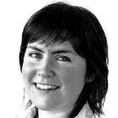What is your research about?
"I am a microbiologist, and I work on a number of projects that look at animal health, infectious agents and water quality. My research relies on teamwork to examine the quality of water in streams, rivers and the sea, and working out sources of pollution that could affect animal and human health as well as economic activity."
What do you track in the water?
"Lots of things. One project I work on is Acclimatize, an EU Interreg project partially funded by the European Regional Development Fund through the Ireland Wales Co-operation programme. We are looking at the quality of bathing water (water where people swim) in Dublin and Wales. In Dublin that means Merrion, Sandymount and Dollymount strands. We monitor pollution in the seawater, including the microbes that signal faecal contamination such as E. coli, and we track pollutants back along rivers and streams to find out there they come from. In another project we are tracking antibiotic resistance genes along waterways. Then there is the Interreg-funded SWIM project, where we develop models to predict local water quality and make these available to the public in real-time with electronic signage on the beach."
How are you innovating in the research?
"I think the way we are bringing the research to a new level is by working in interdisciplinary teams. So we have microbiologists and environmental biologists working with civil engineers (Dr John O'Sullivan) and computer scientists (Prof Gregory O'Hare) to model the movement of water and hence pollution and to build computer models based on what we measure. Importantly, we work very closely on these projects with stakeholders such as local councils, who monitor the water quality with the Environmental Protection Agency and with Irish Water."
What kind of technology enables the work you do?
"We use a range of tools. Some have been around for a long time and others are quite new. One of the newer approaches is around understanding what microbes are in the environment based on their DNA. We can take a water sample and use DNA analysis to see what microbes are present and where they come from – animals or humans. That is thanks to techniques such as quantitative PCR and next-generation sequencing. This is really amazing and it can be applied not just to water but anywhere you find lots of bacteria, such as your gut.
What do you hope the outputs of your research will be?
"We hope in the short term it will mean that people can use amenities without having an adverse impact on their health, and for the longer term authorities will get insights into how climate change could affect the sources of pollution into the future and plan to mitigate that."
What trends are you seeing in your field of work?
"I think the main thing is that people are taking a more holistic view of issues in the environment, not just looking at one thing in isolation, but how systems work. That will really help to give us better insights into environmental and climate changes."
And what do you wish people knew, based on your research?
"The tools we have at our disposal now allow us to gain an unparalleled insight into whole ecosystems at a level of detail that was pure science fiction when I was a student. We now are in a position to understand how various activities affect our environment. Even a single 'event' from a dog, as we euphemistically call it, on the shoreline can have a big impact on the water quality at the beach. So please clean up after your dog."






















